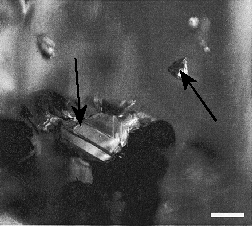To a potential fiancée, flaws in a diamond can warn of a boyfriend with poor judgment—or a thin wallet. To geophysicists, however, some of these flaws may provide priceless clues that are critical to understanding the conditions under which the gems formed.

By analyzing some of a diamond’s trapped impurities, an international team has demonstrated a way to measure remnants of the gargantuan pressure that produced a diamond. The scientists, led by Nikolai V. Sobolev of the Russian Academy of Sciences in Novosibirsk, report their results in the Oct. 24 Proceedings of the National Academy of Sciences.
Diamonds form when masses of carbon experience the elevated temperatures and pressures present at least 120 kilometers below Earth’s surface. Clumps of material trapped in the carbon end up as flaws that typically reveal a range of pressures that the diamond may have endured during formation. For example, coesite—a particularly dense type of quartz—forms at pressures between about 26,000 atmospheres and 69,000 atm. So, its presence doesn’t indicate the specific pressure that created the gem.
When researchers recently fired single-wavelength beams of X rays and then laser light through two small crystals of coesite trapped in a Venezuelan diamond, the patterns of light scattering from the crystals revealed that the material’s atoms are more closely packed than they are at atmospheric pressure. The diamond surrounding the coesite had sealed in remnants of the high pressure that had formed the gem, says Ho-kwang Mao, a geophysicist at the Carnegie Institution in Washington, D.C., and a coauthor of the report.
The distances between atoms in the coesite indicated that the material is currently under a pressure of about 36,000 atm. That corresponds to a pressure of more than 54,000 atm at the elevated temperatures at which the diamond formed, says Mao.
Mao suggests this technique could help link diamonds from a particular mine or region to the specific conditions under which they were produced.
“This research is an elegant application of single-wavelength spectroscopy,” says George E. Harlow, a mineralogist at the American Museum of Natural History in New York. He adds that this technique will provide scientists with a way to learn more directly about the conditions in parts of the Earth’s mantle where diamonds are formed.






